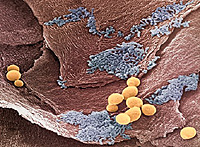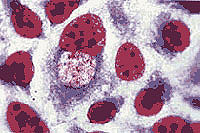Chlamydia is striking a significant part of the population, yielding only to trichomoniasis among sex infections. However, this is a separate infection that has its own characteristics and is treated with strictly defined methods.
Content
 After chlamydia, unfortunately, immunity is not formed to re-infect with chlamydia. When a person is ill, antibodies to chlamydia are produced. First, immunoglobulin M appears, it is included in the fight in acute phase. In the midst of infection and the immunoglobulins A and G are produced during recovery.
After chlamydia, unfortunately, immunity is not formed to re-infect with chlamydia. When a person is ill, antibodies to chlamydia are produced. First, immunoglobulin M appears, it is included in the fight in acute phase. In the midst of infection and the immunoglobulins A and G are produced during recovery.
Since chlamydia is developing inside the cell, falling there by phagocytosis, that is, «Swallowing» The cell itself is observed a powerful protection unit, which is phagocytosis.
Chlamydia destroy the cells in which toxins live. Primary chlamydious focus gradually spreads through the mucous membrane, the speed of which depends on the patient's immunity and the forces of the microorganism itself.
Manifestations and complications of chlamydia
Chlamydia enters the human body through the urinary system. Next, the development of ascending infection is not excluded with the advent of the chalmiosis outside the genitals. Chlamydia can be sharp (rarely), subacute and chronic.
Acute chlamydia ends after 2 months, it is characterized by severe symptoms, which forces to contact a specialist. The duration of chronic chlamydia is more than 2 months, it has erased symptoms or does not appear at all, it is found randomly or after exacerbation.
An unfavorable course of chlamydia leads to complications, the most serious of them are infection of newborns and infertility. Up to 30% of fruitless marriages are due to hidden chlamydia. Untreated chlamydia leads to a variety of losses of pelvic organs. Chlamydia is different, for example, from gonorrhea with a smaller expression of inflammation, but more likely to complications, resistant to treatment. Complications and for flow may differ from the initial period of infection: if chlamydia is complicated by inflammation of pelvic organs, pain can be very sharp. Sometimes chlamydia can capture even the liver.
In men, chlamydia often has the following symptoms:
- Easy redness and small swelling of urethra,
- Weak allocations,
- Pain is usually not,
- Inflammation of the urethra (urethritis)
- Inflammation of the prostate gland (prostatitis),
- Inflammation of the appendages of eggs (epididimitis),
- Additional complaints: frequent urination, itching in the urethre, sometimes crotch pain.
Selection, and so small, in a few days turn into «Morning Dapp». In the urine there may be mucus and pussy. Ureretrite during chlamydia is often caused not only by chlamydia, but also trichomonas, gonococci and t.NS. Prostatitis caused by chlamydia, usually flows in an erased form. Grozny complication of chlamydiosis – Epididimitis (inflammation of the appendages of eggs), often leading to infertility.
 In women, the primary focus of infection is observed in the cervix (cervicitis), and the spread of chlamydia is directed toward the urethra, uterus, pipes. The first manifestations of chlamydia appear in 2-5 weeks after infection. Women notice weak pain and more intense allocations. In case of inspection, the redness, swelling, and small swelling on the mucous membrane. With such symptoms, people often do not appeal to the doctor, which increases the risk of complications of chlamydia. In women, chlamydia proceeds asymptomatic in 90% of cases. Small pains, itching, burning, highlighting – These are all manifestations. Due to the high frequency of the hidden flow of chlamydia and the severity of possible complications, some categories of women must be necessarily surveyed.
In women, the primary focus of infection is observed in the cervix (cervicitis), and the spread of chlamydia is directed toward the urethra, uterus, pipes. The first manifestations of chlamydia appear in 2-5 weeks after infection. Women notice weak pain and more intense allocations. In case of inspection, the redness, swelling, and small swelling on the mucous membrane. With such symptoms, people often do not appeal to the doctor, which increases the risk of complications of chlamydia. In women, chlamydia proceeds asymptomatic in 90% of cases. Small pains, itching, burning, highlighting – These are all manifestations. Due to the high frequency of the hidden flow of chlamydia and the severity of possible complications, some categories of women must be necessarily surveyed.
They belong to them:
- Women who infected their partner inflammation of the urethra of negonoric origin;
- Patients with complicated trichomoniasis and gonorrhea:
- Women with different inflammations of the urogenital sphere (cervix, ovarian, urethra);
- fruitless women;
- Women who are not distinguished in sex contacts.
Diseases caused by other chlamydia
Chlamydious eye damage is developing with a rough violation of hygiene rules and indicates an asymptomatic urinary chlamydia at the most patient or its partner. Sometimes chlamydia getting into the eyes occurs in an infected reservoir. This eye disease is not a trachom, the cause of which is also chlamydia. Trachoma leads to blindness in hot countries and is not interconnected by sexual distribution.
Other varieties of chlamydia cause inflammation of the pharynx, as well as groin lymphogranulomatosis. This is a very painful lesion having extremely unpleasant complications: an emergency increase in the size of genitals, called elephantism, and the scarring of the rectum, which can lead to intestinal obstruction.









